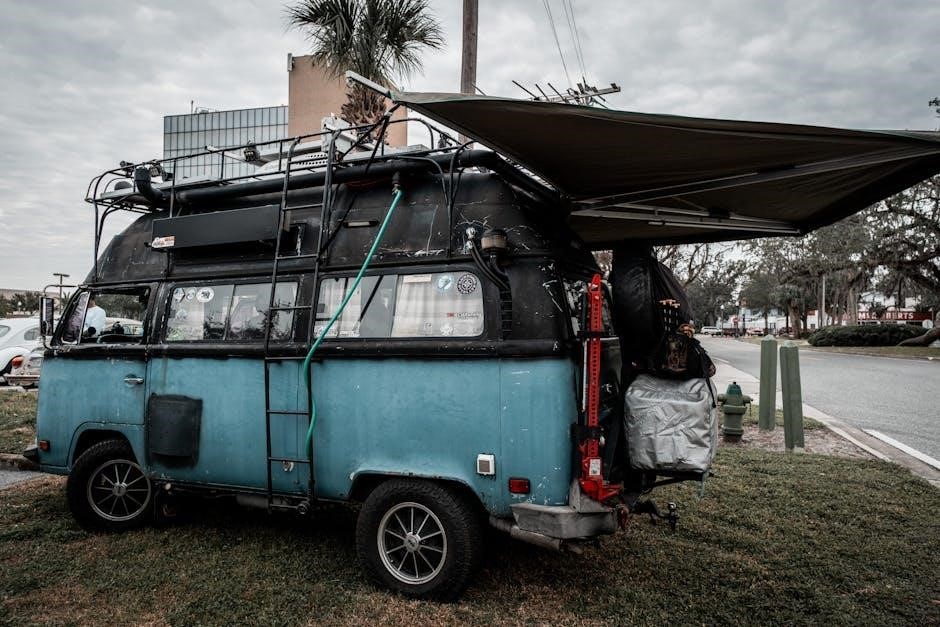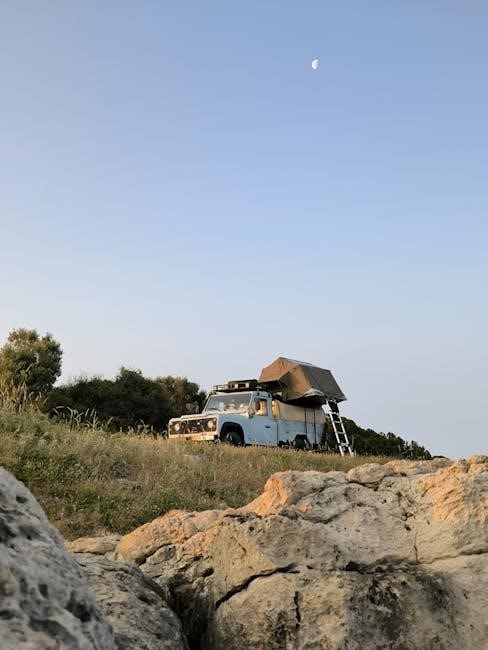Manual camper awnings offer a simple yet effective solution for shade and weather protection, providing an affordable way to extend your outdoor living space while camping.
Overview of Manual Camper Awnings
Manual camper awnings are practical, cost-effective solutions for RV owners seeking shade and weather protection. Designed with durable materials like vinyl or heavy-duty fabric, they provide reliable coverage and extend outdoor living spaces. These awnings typically feature spring-loaded arms, adjustment knobs, and a roller tube, allowing users to set up and tension the canopy manually. Available in various sizes and styles, they cater to different camper models and preferences, offering a straightforward way to enhance comfort and versatility during outdoor adventures.
Benefits of Using a Manual Camper Awning
Manual camper awnings provide cost-effective shade and weather protection, enhancing your camping experience. They are lightweight, easy to maintain, and budget-friendly, making them ideal for campers seeking simplicity. These awnings offer protection from rain, UV rays, and wind, while also creating additional outdoor living space. Their manual operation ensures reliability without relying on power, perfect for off-grid adventures. With fewer mechanical components, they are less prone to malfunctions, offering a practical solution for campers who value durability and ease of use. They are a versatile and essential accessory for any RV or travel trailer setup.

Types of Manual Camper Awnings
Manual camper awnings come in traditional, hybrid, retractable, and fixed designs, offering versatility for shade and weather protection while camping, with options to suit various RV setups and preferences.
Traditional vs. Hybrid Manual Awnings
Traditional manual awnings are fully manual, with spring-loaded arms requiring you to loosen rafter knobs and manually set tension. Hybrid awnings simplify the process with a rotating rod for easy opening. Traditional awnings offer durability and cost-effectiveness, while hybrids provide convenience and faster setup. Both options deliver reliable shade and weather protection, catering to different preferences and needs for campers seeking to enhance their outdoor experience.

Retractable vs. Fixed Manual Awnings
Retractable manual awnings offer flexibility, allowing you to extend or retract the canopy as needed, providing shade and protection when desired. Fixed awnings remain permanently installed, offering constant coverage. Retractable awnings are ideal for variable weather conditions and storage convenience, while fixed models are better for long-term use and structural integrity. Both types enhance outdoor living spaces but cater to different camper preferences and needs, ensuring optimal functionality and durability.

Key Components of a Manual Camper Awning
A manual camper awning includes durable fabric, sturdy arms, a roller tube, and rafter knobs, working together to provide reliable shade and weather protection.
The Role of Arms and Their Function
The arms of a manual camper awning provide structural support and stability. Made from durable materials like metal, they are adjustable and attach to the RV’s side. The arms are spring-loaded, allowing for easy extension and retraction of the awning fabric. They play a crucial role in maintaining tension, ensuring the awning remains taut and properly aligned. Adjusting the arms is essential for achieving the right pitch to prevent water pooling and ensure optimal performance in various weather conditions. Proper arm function is vital for the awning’s durability and effectiveness.

Importance of Fabric Material and Durability
The fabric material of a manual camper awning is crucial for its performance and longevity. Heavy-duty vinyl or durable polyester fabrics are ideal, offering superior sun protection, water resistance, and breathability. High-quality materials ensure the awning withstands harsh weather conditions, including heavy rain and strong winds. Proper maintenance, such as regular cleaning and drying, extends the fabric’s lifespan. A durable fabric also reduces the risk of sagging or tearing, ensuring reliable shade and protection during outdoor adventures. Investing in a sturdy, weather-resistant fabric is essential for maximizing the awning’s functionality and durability over time.

How to Choose the Right Manual Camper Awning
Consider size, material, and weather resistance when selecting a manual camper awning. Ensure it fits your camper’s measurements and choose durable fabrics for longevity and performance.
Factors to Consider: Size, Material, and Installation

When choosing a manual camper awning, consider size to ensure proper fit and coverage. Measure your camper to select the appropriate length and width. Material durability is crucial, with options like heavy-duty vinyl offering weather resistance and longevity. Installation ease is another key factor, as improper attachment can lead to damage or instability. Ensure the awning is compatible with your camper’s roof type and attachment points. Additionally, consider the weight and portability, especially for frequent setups and teardowns. Proper installation ensures stability and prevents damage, making it essential for safe and effective use.
Weather Resistance and Maintenance Tips
Weather resistance is a key feature of manual camper awnings, with durable materials like heavy-duty vinyl offering protection against rain and UV exposure. Regular cleaning is essential to maintain water repellency and prevent mold growth. After use, ensure the awning is completely dry before storage to avoid mildew. Adjusting the awning to ensure proper drainage prevents rainwater pooling, which can cause sagging or damage. Store the fabric in a clean, dry place during off-seasons to extend lifespan. Proper maintenance ensures the awning remains reliable and performs well in various weather conditions.

Installation and Setup Guide
Attach the awning to your camper, ensuring proper fit and alignment. Loosen rafter knobs, walk out the awning, and manually set tension for a secure installation.
Step-by-Step Instructions for Manual Awning Installation
Start by attaching the awning to your camper, ensuring proper alignment with the roof edge. Loosen the rafter knobs and carefully walk the awning out to extend it fully. Once extended, tighten the knobs to secure the arms in place. Adjust the awning to ensure proper tension and drainage, with one corner slightly lower to prevent rainwater pooling. Double-check all connections for stability. Finally, clean the fabric regularly to maintain durability and appearance. This process ensures a safe and efficient setup for your manual camper awning.
Adjusting the Awning for Proper Tension and Drainage
Adjusting your manual camper awning for proper tension and drainage is essential for optimal performance. Begin by tightening the rafter knobs until the fabric is snug but not overly taut. Ensure even tension across the awning to prevent sagging. For drainage, position the awning so one side is slightly lower, allowing rainwater to flow off efficiently. Regularly inspect and adjust the tension to maintain stability and prevent water pooling. Proper adjustments will extend the lifespan of your awning and enhance your camping experience.

Maintenance and Care
Regular cleaning with mild detergent and thorough drying prevent mold. Store in a dry place, away from pests and harsh weather. Inspect for damage regularly to ensure longevity.
Cleaning and Storing the Awning Fabric
Regular cleaning is essential to maintain the durability of your manual camper awning fabric. Use a mild detergent and water to gently scrub away dirt and stains, avoiding harsh chemicals or abrasive cleaners that could damage the material. Allow the fabric to air dry completely before storing to prevent mold and mildew. When storing, roll the fabric neatly and keep it in a dry, protected area away from pests. Inspect for any tears or damage before storage and address them promptly to ensure longevity.
Tips for Extending the Lifespan of the Awning
To maximize the lifespan of your manual camper awning, ensure proper setup and tension to avoid structural stress. Regularly clean the fabric with mild detergent and water, avoiding harsh chemicals. Allow the awning to dry completely before storing to prevent mold. Adjust the tension periodically to prevent sagging, especially during rainy or windy conditions. Inspect the fabric and hardware annually for wear and tear, addressing any damage promptly. Store the awning in a dry, protected area during the off-season to avoid prolonged exposure to the elements.
Safety Considerations
Ensure proper tension to prevent rainwater pooling and adjust one corner lower for drainage. Secure the awning tightly in windy conditions to avoid damage or detachment.
Preventing Rainwater Pooling and Damage
Properly adjusting your manual camper awning is essential to prevent rainwater pooling. Ensure one corner is slightly lower to allow water to flow off. Clean the fabric regularly to maintain its water-repellent properties. Tighten all hardware and check for sagging areas, as these can trap water. Avoid leaving the awning unattended in heavy rain or strong winds, as pooling water may cause structural damage or stretching. Regular maintenance, like inspecting seams and reapplying waterproof coatings, can extend the awning’s lifespan and ensure optimal performance during wet conditions.
Securing the Awning in Windy Conditions
Securing a manual camper awning in windy conditions is crucial to prevent damage or detachment. Always ensure the fabric is tightly stretched and properly tensioned using the adjustment knobs. Consider using additional support legs or tie-down straps to stabilize the arms and frame; In strong winds, it’s advisable to lower the awning slightly to reduce wind resistance. Regularly inspect the hardware and tighten any loose components. If winds are extreme, retracting the awning entirely may be the safest option to protect your camper and ensure the awning remains intact.

Troubleshooting Common Issues
Common issues with manual camper awnings include leaks, sagging fabric, or difficult retraction. Inspect for loose connections, clean debris from the mechanism, and tighten any worn parts for optimal performance.
Addressing Leaks, Sagging, or Difficult Retraction
Leaks in manual camper awnings often stem from worn seams or punctures. Apply waterproof sealants to affected areas and ensure fabric is clean. Sagging can be resolved by tightening the arms and adjusting tension knobs. For difficult retraction, check for debris or obstructions in the mechanism and lubricate moving parts. Regular cleaning and inspection of the awning fabric and hardware are essential to prevent these issues. Ensure proper alignment and tension during setup to avoid structural strain and extend the awning’s lifespan.
Manual camper awnings are a practical and cost-effective way to enhance your camping experience, offering shade, protection, and extra living space with minimal maintenance required.
Final Thoughts on Manual Camper Awnings
Manual camper awnings are a cost-effective and durable solution for enhancing your camping experience. They offer shade, protection from the elements, and additional living space. With various sizes and materials available, such as heavy-duty vinyl, they cater to different needs and budgets. Easy to install and maintain, manual awnings are a practical choice for both occasional and full-time campers. Their simplicity and reliability make them a popular option for those seeking to upgrade their RV setup without breaking the bank. Investing in a quality manual awning ensures years of enjoyable outdoor adventures.

